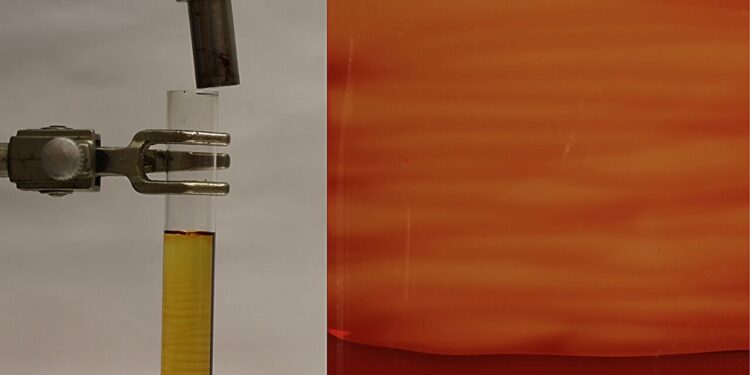Credit: Beckman Institute for Advanced Science and Technology
Biological systems are renowned for their ability to create strong yet resilient structures. A sea sponge, for example, grows in layers, forming unique patterns that integrate minerals with softer regions, creating an ideal balance between strength and flexibility.
“Nature has a knack for transforming weak materials into strong ones through intricate patterns,” says Nancy Sottos, a researcher at the Beckman Institute for Advanced Science and Technology and the Maybelle Leland Swanlund Chair in the Department of Materials Science and Engineering at the University of Illinois at Urbana-Champaign. “Patterned materials often contain areas of hardness and softness, allowing them to withstand high stresses without breaking while maintaining impressive strength.”
A study published today in Nature describes how Sottos and his colleagues used frontal polymerization, a process that uses heat to trigger a chemical reaction that forms polymers, to replicate nature’s approach.
In a 2021 study, Sottos and colleagues established that frontal polymerization is a reliable method for making biologically inspired polymer materials. Now, their new technique builds on this method by enabling the controlled formation of crystalline patterns in these materials, significantly improving their strength and durability.
“Nature captivates us with spontaneous patterns formed by dissipation processes, but in the world of synthetic materials we typically rely on precise, controlled methods to create structure,” said Jeff Moore, a researcher at Beckman.
Moore, who is also the Stanley O. Ikenberry Research Professor and professor emeritus of chemistry at Illinois, was instrumental in developing the chemical formulations that led to the discoveries highlighted in the paper.
“Our work demonstrates a new frontier: creating patterns on materials without molds or milling, resulting in unique properties that arise from this added structure,” he said.
Using the morphogenic fabrication technique, the group made slight modifications to the chemical reactions to achieve a crystalline pattern.
“It took several weeks to determine the optimal reaction conditions. However, observing the spin mode dynamics that resulted in these extraordinary changes in the patterned microstructure and material properties was a particularly rewarding experience,” said lead author Justine Paul, a former Beckman Institute graduate fellow.
The result was a material that included regions of amorphous, or unstructured, elements, as well as crystalline solid areas. The contrast between rubbery and rock-solid materials can make a product particularly strong. Similarly, creating a new way to control the architecture of a polymer would not have been possible without the interdisciplinary collaborations within the Beckman Institute.
Cecilia Leal, professor of materials science and engineering, used X-ray scattering to reveal how polymer chains orient themselves in the patterned material. The technique highlighted the importance of deciphering holistic structure-property relationships from molecule to matter, she said.
Aerospace engineering professor Philippe Geubelle focused on modeling the manufacturing process, with an emphasis on capturing the thermochemical instabilities that lead to the creation of unique heterogeneous materials.
“The close collaboration between experimentalists and modelers, and between researchers in mechanics, materials science and chemistry, was crucial to the success of this project,” Geubelle said.
Sottos, Moore, Leal and Geubelle are part of the Beckman Institute’s Autonomous Materials Systems Working Group.
“This achievement required the combined expertise of an interdisciplinary team, making the collaborative environment of the Beckman Institute the ideal setting for such a breakthrough,” Moore said.
More information:
Nancy Sottos, Controlled modeling of crystalline domains by frontal polymerization, Nature (2024). DOI: 10.1038/s41586-024-07951-7. www.nature.com/articles/s41586-024-07951-7
Provided by the Beckman Institute for Advanced Science and Technology
Quote: Nature-inspired patterns boost polymer strength (September 18, 2024) retrieved September 18, 2024 from
This document is subject to copyright. Apart from any fair dealing for the purpose of private study or research, no part may be reproduced without written permission. The content is provided for informational purposes only.



